April 22, 2016
Air Date: April 22, 2016
FULL SHOW
SEGMENTS

UN Climate Chief Calls for Urgent Action
View the page for this story
Earth Day 2016 brought a significant milestone for the Paris Agreement, as some 175 nations signed on at the UN Headquarters in New York City. Yet the ambitious goals of this climate agreement are not guaranteed without aggressive moves to curb carbon pollution. Host Steve Curwood sits down with Christiana Figueres, Executive Secretary of the UN Framework Convention on Climate Change, to discuss what’s required to give civilization a fighting chance. (17:00)

Paris and Climate Justice
/ Emmett FitzGeraldView the page for this story
As the climate talks in Paris drew to a close, activists gathered in the streets to demand a global shift away from fossil fuels and protection of the people most vulnerable to the impacts of global warming. Living on Earth’s Emmett Fitzgerald recorded an audio postcard from the protests. (02:15)
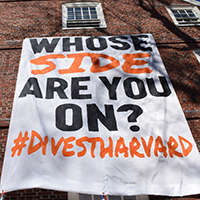
Next-Gen Climate Activism
View the page for this story
Student activists calling for a shift away from fossil fuels say that institutions that refuse to act forfeit their status as moral leaders. Harvard Law student Ted Hamilton discusses with host Steve Curwood the lawsuit that’s attempting to compel Harvard to divest its portfolio of fossil fuels, and the connections between divestment and the broader climate movement. (07:10)
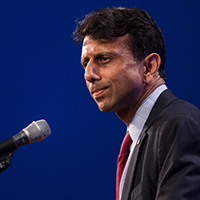
Beyond the Headlines
/ Peter DykstraView the page for this story
Peter Dykstra and host Steve Curwood look at a remote indigenous tribe in Guyana that used the internet for plans to build a drone to monitor illegal deforestation, discuss Republican lawmakers and right-wing media who once accepted climate change, but have since flip-flopped, and look back at things that have gotten better, worse or stayed the same since the first Earth Day in 1970. (04:20)
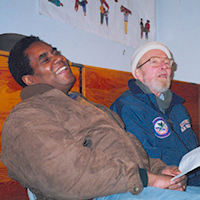
Happy Birthday, Living on Earth!
View the page for this story
Twenty-five years ago, Living on Earth started its weekly broadcasts with the mission to tell the story of climate change, though few in the public cared at that time, along with pollution, human health and habitat loss issues. Over the years, the threat of global warming has grown more acute and increasingly prominent in popular awareness, but as host and Living on Earth founder Steve Curwood tells us, we are nearly out of time to avoid plunging into the climate abyss. (01:45)
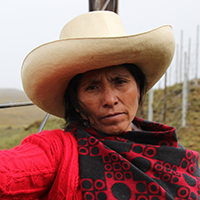
The 2016 Goldman Environmental Prizes
View the page for this story
The Goldman Foundation annually honors six activists from around the world who have fought for the protection of the environment. The murder of one of last year’s winners, Berta Cáceres from Honduras, has put this year’s awards in an even brighter spotlight. Host Steve Curwood profiles this year’s winner from Latin America, Máxima Acuña of Peru, who fought a proposed gold mine on her farm, at the expense of being sent to jail and having her house knocked down and her potato crop destroyed. (05:00)
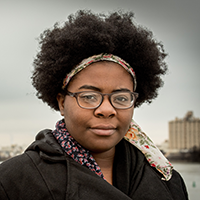
The 2016 North American Goldman Prize Winner, a Student from Baltimore
View the page for this story
Destiny Watford was still a high school student when she discovered a massive trash incinerator planned for her home town would likely be a source of choking pollution. She tells host Steve Curwood how she galvanized her fellow students and citizens to oppose this source of jobs, and about her success. (08:45)
Show Credits and Funders
Show Transcript
HOST: Steve Curwood
GUESTS: Christiana Figueres, Ted Hamilton, Destiny Watford
REPORTERS: Emmett FitzGerald, Peter Dykstra
[THEME]
CURWOOD: From Public Radio International, this is Living on Earth.
[THEME]
CURWOOD: I'm Steve Curwood. In celebration of Earth Day, some 150 nations send high-level representatives to the UN to sign the Paris Climate Agreement, but the window to act on global warming is closing fast.
FIGUERES: I feel that that agreement, if we lived in a perfect world, is actually coming too late. We should have come to that kind of an agreement perhaps 10 years ago, and we're five minutes to 12. So the speed and scale of implementation is going to have to be pretty aggressive.
CURWOOD: Also, the Goldman Foundation awards its annual prizes to environmental heroes – and pays tribute to one of last year’s winners, Berta Caceres.
POETS: We will stand for justice and feel our feet planted in every ounce of soil that we have always belonged to, knowing that we are safe, knowing that when you return to us we will become millions.
CURWOOD: That and more this week, on Living on Earth. Stick around.
[NEWSBREAK MUSIC: Boards Of Canada “Zoetrope” from “In A Beautiful Place Out In The Country” (Warp Records 2000)]
ANNOUNCER: Support for Living on Earth comes from United Technologies. Innovating to make the world a better more sustainable place to live.
UN Climate Chief Calls for Urgent Action

From left: Christiana Figueres, Executive Secretary of the UN Framework Convention on Climate Change (UNFCCC); UN Secretary-General Ban Ki-moon; Laurent Fabius, Minister for Foreign Affairs of France and President of the UN Climate Change Conference in Paris (COP21); and François Hollande, President of France celebrate after the historic adoption of Paris Agreement on climate change. (Photo: United Nations Photo, Flickr CC BY-NC-ND 2.0)
CURWOOD: From the Jennifer and Ted Stanley studios at the University of Massachusetts Boston and PRI, this is Living on Earth. I’m Steve Curwood.
To mark Earth Day, leaders and diplomats from more than 150 countries converged on the United Nations in New York to sign the Paris Climate Agreement at the opening of the yearlong window for its adoption. Back in 2014 US Secretary of State John Kerry and China’s State Councilor Yang Jiechi struck a deal to work together to make deep emissions cuts, a deal that became the main architecture of the Paris Agreement. Still, bringing in more than 180 other nations and getting the strong commitment of business leaders for the Paris negotiations wasn’t easy. Many credit the skillful, tireless diplomacy from UN Climate conference chairman and French foreign minister Laurent Fabius, and the brilliant leadership from the Executive Secretary of the UN climate process, Christiana Figueres, who was welcomed like this.
[CHEERING]
CURWOOD: At the party that some delegates, environmental and civil society activists held the night the agreement was sealed. The Living on Earth team was there. We whipped out our cellphones to record the euphoric response. And Christiana Figueres joins me again now. Welcome!

Figueres says that while the Paris Agreement is an important climate diplomacy milestone, it should have been reached about ten years ago. (Photo: UN Photo / Eskinder Debebe, Flickr CC BY-NC-ND 2.0)
FIGUERES: Well, thanks very much, Steve.
CURWOOD: You know the last time I saw you, you were practically crowdsurfing in this wild celebratory party in Paris. How does it feel to be a rockstar?
FIGUERES: Honestly, that last night was such a crazy night. It was a fantastic celebration. We had so many people from so many different sectors, so many different countries, all of whom were truly ecstatic, and ecstatic I think because so many people worked for so many years to get to a global agreement, and we did, and the result was in fact even more ambitious than most people thought was going to be possible. So, yeah, it was a very celebratory night.
CURWOOD: How do you feel about the Paris agreement now?
FIGUERES: A couple of thoughts. Yes, I would agree with the celebration mood that night. It was historic, it was unprecedented and truly the result of a lot of hard work from thousands and thousands if not millions of people, honestly. I also am quite happy about some of the very technical results of that allow us to now guide the transformation of the global economy toward a decarbonized society over time. So, that's the good news. The bad news honestly is that I feel that that agreement if we lived in a perfect world is actually coming too late. In a perfect world we should have come to that kind of an agreement perhaps 10 years ago. I know that it was not possible 10 years ago. We know that we weren't ready, but just from a science point of view, just from an intense vulnerability of populations point of view we're really running against the limit here, so what it has done is put a lot of pressure now on the implementation of that agreement, and again in a perfect ideal world we would have a little bit more time to implement, but now we're five minutes to 12, so the speed and scale of implementation is going to have to be pretty aggressive.

Figueres speaking at COP21 (Photo: Iga Gozdowska / WeMeanBusiness, Flickr CC BY 2.0)
CURWOOD: When you say five minutes to 12, what are you thinking of in terms of scientific terms?
FIGUERES: What I'm thinking of is a something that is not in the Paris agreement, which is when do we actually have to get to the maximum point of emissions, which is called peaking and begin to descend. We should be peaking within this decade. We should be peaking by 2020 for one purpose, which is to protect the most vulnerable populations because peaking after that is going to mean that we have accumulate greenhouse gas concentrations that make it very very difficult for the survival or even adaption of the most vulnerable populations. Now, most vulnerable populations are in developing countries. The irony of this whole exercise is that developing countries themselves will have to make an effort for their own security and that is a tough pill to swallow right because developing countries do not have the historical responsibility, they're moving into a position of responsibility into the future but they do not have the historical responsibility and yet if developing countries do not act they are working against their own interest.
CURWOOD: Let's talk about some of the numbers in Paris. The goal, I believe, is to keep things below 2.0 degrees Centigrade rise...

The meeting hall at COP21 (Photo: Iga Gozdowska / WeMeanBusiness, Flickr CC BY 2.0)
FIGUERES: Well below, and make every effort to keep it under 1.5.
CURWOOD: How important is that?
FIGUERES: It's critical. It is truly, truly critical, and it is most critical for the most vulnerable populations. Again, you know the guiding star here is how are we going to protect the most vulnerable because these are countries and populations that are exempted of emission responsibility. That does not mean that they're exempted of action responsibilities - two different types of responsibility. And you know one of the very rays of light and hope of the Paris agreement is that every country agreed that they want to contribute even if it's in a small way. However we cannot lose sight of the fact that vulnerability and impact truly is accessed exacerbated upon some populations and if we do not get to 1.5, if we go...first of all if we go above two, Steve, I have to share with you the insurance industry has already determined that a world that goes above two degrees is uninsurable. You and I do not want to live in a world that is uninsurable and certainly the corporate world does not want to operate in a world that is uninsurable. So that's already one economic threshold. Now the human threshold is the 1.5 because what the 1.5 does...it doesn't even guarantee the survival of the most vulnerable, it gives them a fighting chance.
CURWOOD: One problem, the independently determined national commitments these INDCs, they...
FIGUERES: I'm going to finish your sentence for you, OK, they do not add up to 1.5 or two degrees.
CURWOOD: A very toasty 2.5 or more.

In some developing countries, the cost of borrowing money can be as much as three times higher than in the developed world, creating a barrier for clean energy projects like this solar thermal plant in India. (Photo: Brahma Kumaris, Flickr CC BY-NC 2.0)
FIGUERES: 2.7 to 3 is what they have. So, what's the good news there? The good news of the INDCs is that in a world without those climate change plans we were headed for a world that would've increased forward to five and by some accounts even six degrees. Frankly, a completely unviable world.
CURWOOD: Does it matter? I mean, because if the world is uninsurable at two degrees, if it's really even a challenge for folks to survive at 1.5, once you get to three or four or five...
FIGUERES: Then what it means is it's a very unfair selection right because it is those that have the most resources to be able to afford the adaptation to those conditions that would be the ones who would have a chance, and the others who don't have those resources would have no chance. That's not the world we want to live in right? So the good news of the INDCs is that we have at least shaved off the worst scenario, the worst consequences. So that's better, but it's not where we want to be. And because we knew this ahead of the time and I had warned the press at least a year ahead, and I actually told them if any of you come and you all of a sudden have a eureka moment in Paris and say [gasps] "discovery, the INDCs do not get us to well below 2 degrees," I'm going to chop your head off because I'm telling you now a year before Paris that they do not get us there, and that is why the Paris agreement has a very very different logic to the Kyoto Protocol. The Kyoto Protocol is a static commitment that by X year you will have reduced X amount. The Paris agreement does not have that deadline. What the Paris agreement does is it establishes a process throughout which countries will increase their emission reductions and certainly their resilience. So, my guess is we're probably going to go through a 10, 15 maybe a 20 year process of constant improvement, constant increase in efforts to reduce emissions until we get to where we need to get to.

Multinational development banks can help link up the supply of capital for climate-conscious development projects with the need. In Sierra Leone, the African Development Bank is funding the NERICA project carried out by the African Rice Initiative. (Photo: R.Raman, AfricaRice, Flickr CC BY-NC-ND 2.0)
CURWOOD: So, if we were to do a little bit of math, humanity is emitting someplace between 8 to 10 gigatons of carbon...
FIGUERES: 32 a year.
CURWOOD: 32 gigatons of carbon a year. Oh my so...
FIGUERES: I think I'm picking up your thoughts here, Steve. So here's the math. OK, we already have 2000 gigatons up there in the atmosphere right? If we want to stay under two degrees, we only have a sum total of another thousand gigatons that we can put up there. That's not for this year or for this decade or for this century. That is 1000 gigatons for as long as humans intend to stay on this planet unless we invent some other absorption of carbon methodology that we don't have yet. If we want to stay under 1.5 we only have 600 gigatons, so you do the math.
CURWOOD: Let's do the math. So roughly we have 30 years to eliminate these emissions.
FIGUERES: No we don't. We don't have 30 years. We have much less than that because if we are to take those 30 years then you are assuming that we're going to go with 32 every year and then we're going to go from 32 to 0. Well, that is not realistic. There is no way that the economy, that transportation, that energy, that agriculture can go from 32 on the 31 December of year whatever and by January we're down to zero. We have to be able to buy ourselves the time for a smooth transition.
CURWOOD: Christiana Figueres is the Executive Secretary of the United Nations Framework Convention on Climate Change. And we'll be back in just a moment.
ANNOUNCER: Support for Living on Earth comes from the Gordon and Betty Moore Foundation, and from Wunder Capital, an online investment platform that allows individuals to invest in solar projects across the U.S. More information and account creation at Wunder Capital.com. That's Wunder with a 'U'. Wunder Capital: do well and do good.
CURWOOD: Just ahead...why it costs many developing countries much more than the US and Europe pay to finance climate resilience. Stay tuned to Living on Earth.
[CUTAWAY MUSIC: Jacqueline Schwab, “I Heard From Heaven Today,” Down Came an Angel, traditional Georgia Sea Islands/arr.Jacqueline Schwab, Dorian Recordings]
CURWOOD: It’s Living on Earth, and I’m Steve Curwood. We're back now with Christiana Figueres. She's Executive Secretary of the United Nations Framework Convention on Climate Change. I want to talk more about developing countries. At the Paris meeting some folks from developing countries pointed out one of the big obstacles around finance is the interest rate of the environment, that when European and American companies go into the capital markets, they borrow at two, three, four percent, whereas, if you're in India or Cameroon, you're going to pay 12, 15 percent, and that therefore there's a tremendous advantage that the rich part of the world has over the developing world, and yet the developing world needs lots of capital resources. How do we get around that?

The Paris Agreement will be open for signing at the UN Headquarters in New York City through April 21st, 2017. (Photo: Jim, the Photographer, Flickr CC BY 2.0)
FIGUERES: In general, it's true. It's not true for every single developing country, but in general it is true that developing countries face a higher cost of capital than industrialized countries. Why is that? Because A: there is at least a perception whether it's true or not, but there's a perception of political risk, there's a perception of policy risk meaning that some countries put a policy in and then take it out, there's a currency risk, and there is what I call the risk of the unknown because a lot of capital we just don't have a long-standing tradition of investing the levels of investment that need to go in now into the developing world, right? We're getting there but it still is considered a very risky business. So from an investor point of view you can't blame them because they have to give a value to that risk. So the challenge here in bringing down the cost of capital is you need to bring other financial institutions whose bread-and-butter it is to work in our developing countries, who understand our realities and who actually have the possibility and the understanding of taking that risk off the table. So here I'm talking for example very specifically about development banks. The InterAmerican bank knows Latin America very well. The African Development Bank knows the African countries very well. They know all the quirks. They have been working there for years. It is their responsibility to actually work here and you have to be very specific to go into the INDCs that all of these countries have put on the table and work with other financial situations so that the development banks can be helpful in developing the kind of financial instruments that are necessary to buy down some of the risk and then attract foreign capital investment that can go in there at a cost of capital that is competitive.
CURWOOD: Why isn't that happening? We're facing a climate emergency, the people do need to develop a sustainable low carbon way, not much time and yet the money doesn't seem to be moving in this...
FIGUERES: I completely agree. I've come to the conclusion that we have moved from the financial crisis of 2008 to the financial emergency of 2016 and the fact is that today 2016 we see capital that has been accumulating since 2008 because there's no place to put the capital so you have an accumulation of capital over here with my left hand and with my right hand you have an enormous need for investment particularly in infrastructure both for energy generation, for transport and all of the infrastructure that is necessary for adaptation, and so you have supply and demand and they're not talking to each other yet. I am feeling a huge urgency around how do we build the bridge. Big question mark.

What the world needs now is a sense of urgency about the climate crisis, says Figueres. (Photo: NASA Goddard Space Flight Center, Flickr CC BY 2.0)
CURWOOD: So you worked really hard on this, six years you've served as executive secretary, and you're about to leave. What's ahead for you? What you do to top this?
FIGUERES: Well, it is difficult to top honestly. It's been a true privilege and an honor to support all governments and so much of the private sector that is actually also companies as well as civil societies. It has just been a fantastic opportunity to have that breath and depth of collaboration for a true common clause, but what do I do after the 7th of July? Honestly, it's still unknown. There are many balls in the air. There are many muffins in the oven and I'm still trying to decide which of those muffins do I want to prioritize and pull out of the oven. So, stay tuned.
CURWOOD: They need a new secretary-general at the UN.
FIGUERES: Not they. We. We the population. We the people need a new secretary-general at the UN and I am actually quite happy about the fact that it does seem that there is a huge political push for that to be a woman, and I think it is about time after 70 years of the United Nations and eight secretary-generals, it's about time that there be a woman. We also know that if we followed geographic rotation, it is the turn of Eastern Europe and there are currently quite a few female candidates, some male also, but quite a few female candidates from Eastern Europe and from other regions. So we will wait and see what happens.

Christiana Figueres is the Executive Secretary of the United Nations Framework Convention on Climate Change (UNFCCC). She will be stepping down from the position this July. (Photo: COP PARIS, Flickr public domain)
CURWOOD: To wrap this up, so if you were in charge of all of this what you do to get this to respond to the tremendous challenges that the science tells us we have?
FIGUERES: No, I'm very happy and I think everybody is about the direction that we're moving in because we are moving incontrovertibly and unstoppably toward a decarbonized world and a more resilient world. The piece that is not there yet is the sense of urgency. The fact is that we would move toward that decarbonized society and a more resilient infrastructure globally anyway because that is already started, but what we need to do is increase the speed so I'm on a personal campaign to invite every person that I need to swallow an alarm clock and to realize that you know this is ticking inside of us. We just cannot rest on our laurels and this is not about business as usual. This is a new definition of BAU, business as urgent. So, let's swallow the alarm clock, step up to the plate, and increase the speed with which we taking all of these fantastic decision but that are not happening fast enough.
CURWOOD: Christiana Figueres is the Executive Secretary of the UN Framework Convention on Climate Change. Thanks so much for taking this time with us today.
FIGUERES: Thank you very much, Steve, for the invitation to be here with you today. I really enjoyed it.
Related links:
- About the Paris climate negotiations
- About Christiana Figueres
- USA Today: “175 Nations Sign Historic Paris Climate Deal on Earth Day”
- New York Times: “Leaders Roll Up Sleeves on Climate, but Experts Say Plans Don’t Pack a Wallop”
- World Resources Institute: More about climate finance
Paris and Climate Justice
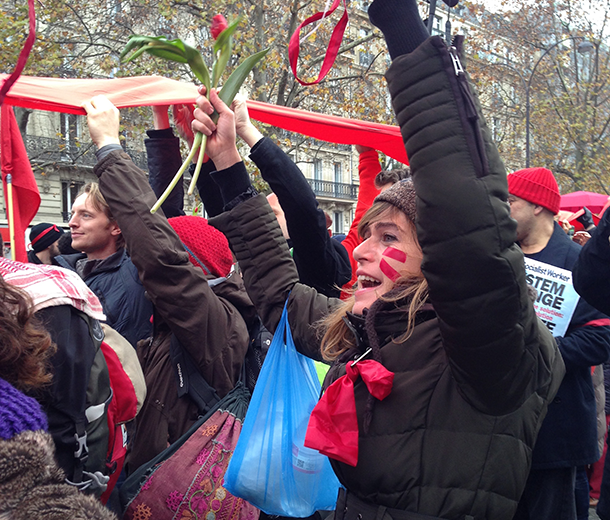
Police lifted the ban on protest, and activists gathered in the streets of Paris as the climate conference wound down. (Photo: Emmett FitzGerald)
CURWOOD: Young activists spoke out forcefully at the Paris Climate talks, demanding in a variety of creative ways that the world put the brakes on the present rush to the climatic abyss. In the face of a demonstration ban imposed at first during the talks by the French government, which was still reeling from the terrorist attacks, activists held a “shoe-in” that even include a pair from Pope Francis.
And when deal was finally struck and the demonstration ban lifted activists stretched huge red banners through the streets of the French capital, symbolic of the “red lines” that climate change must not cross. Living on Earth’s Emmett Fitzgerald took his microphone there.
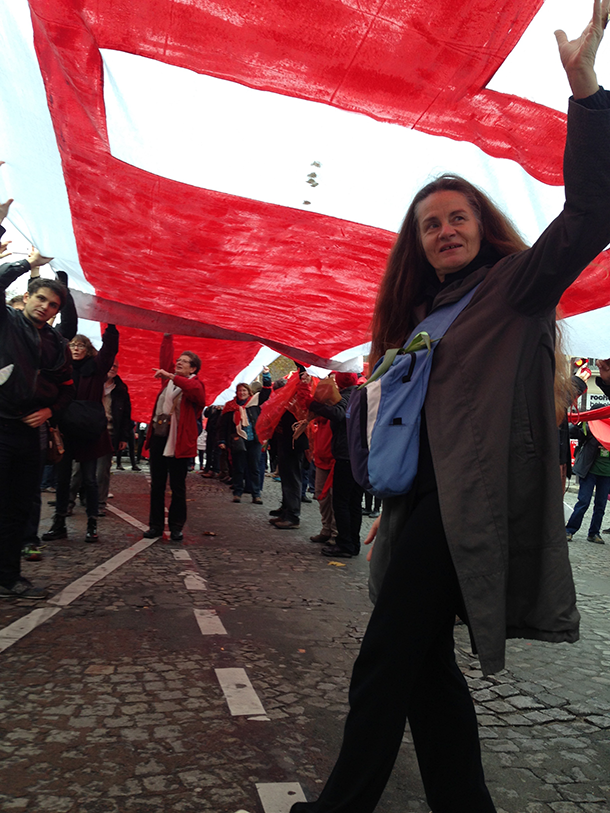
Protesters stretched red banners through the streets to symbolize the red lines that cannot be crossed if we are to keep the planet safe. (Photo: Emmett FitzGerald)
CHANTING: Hey hey, ho ho, fossil fuels have got to go! Hey hey, ho ho, fossil fuels have got to go! Hey hey, ho ho, fossil fuels have got to go!
PROTESTER1: My name is Kit Bennett. I am from York in England. One of the reasons I am here is because my government says that it's acting on climate and the Paris climate change conference. That's a lie. They are supporting fracking they are cutting funds to renewable energy. We need to show that we don´t support the actions of the British government and so many of the governments of the world that have only false solutions to the problems of climate change.
PROTESTER2: It´s a worse deal than in Kyoto 18 years ago. That´s why the frontline of climate change isn´t the politicians its people like us, blockading, keeping the fossil fuels in the ground, its fracking in western England, in eastern Europe its brown coal, and that is the way forward.
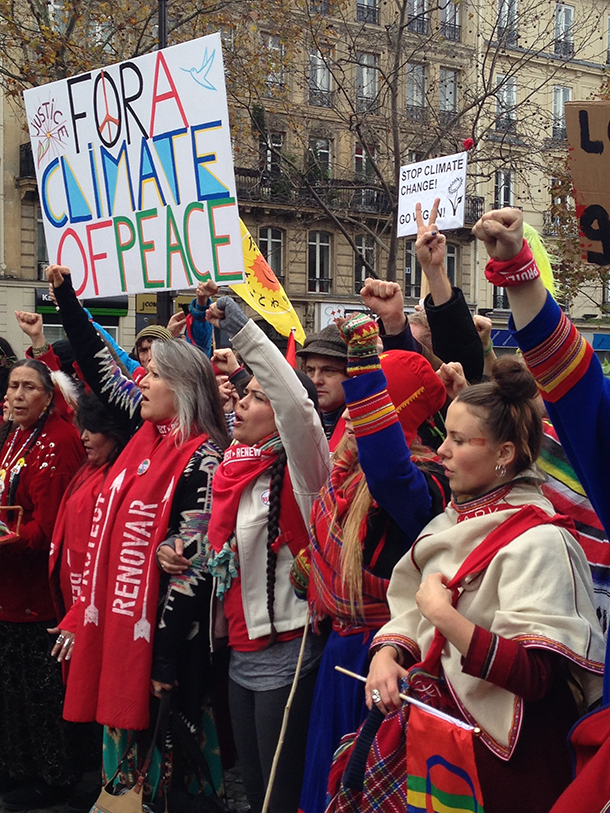
Indigenous people—often on the front lines of climate impacts—led the march. (Photo: Emmett FitzGerald)
PROTESTER3: My name is Clayton Thomas Mueller and I´m a Cree from Northern Canada, Treaty Six Territory. I´m here to demonstrate that indigenous peoples we are the red line. We are hit first and worst by climate change and its associated drivers like for example Canada´s controversial tar sands development in Northern Alberta. So we are here with 35 indigenous representatives from the frontlines of the fight against the fossil fuel regime in North America to stand in solidarity with people from across the planet that are fighting for climate justice.
CHANTING: What do we want? Climate justice! When do we want it? Now!
[MUSIC – STREET BAND AT THE DEMONSTRATION IN PARIS]
Related links:
- Listen to Living on Earth’s original coverage at the start of the Paris climate talks
- LOE’s coverage of the historic Paris Agreement
- More photos from the Red Lines protest
Next-Gen Climate Activism
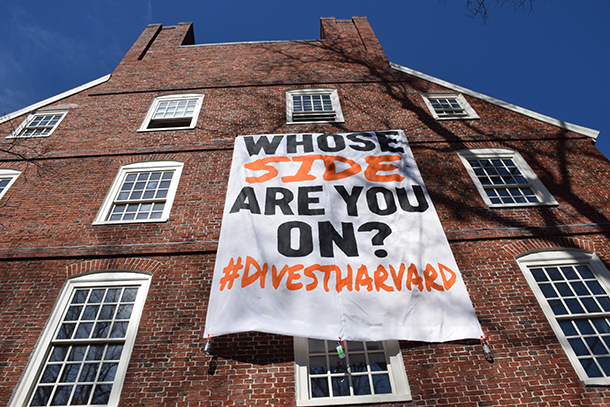
Students hung a Divest Harvard banner on one of the college’s dorm buildings last April, as part of the student-organized “Harvard Heat Week” events calling for divestment. (Photo: Jamie Henn / 350.org, Flickr CC BY-NC-SA 2.0)
CURWOOD: Like the campaigners in Paris, back in 1970 the first Earth Day saw many activists and concerned citizens take to the streets. But those demonstrations mostly focused on air and water pollution and mindless development. Although there are still plenty of protests against pollution, sprawl and habitat loss, today much of the environmental movement is focused on the changing climate, and climate justice and responsibility are just what Ted Hamilton is calling for. He’s a Harvard University Law Student, a member of the Divest Harvard student group and a plaintiff in the student lawsuit that’s asking the courts to order Harvard College to divest its endowment from fossil fuels. Ted Hamilton, welcome to Living on Earth.
HAMILTON: Thank you for inviting me.
CURWOOD: Now, most people who come to Harvard Law School don't come to rock the boat. A law degree from Harvard is generally a ticket to everything from the presidency of United States, Supreme Court, major law firms. Why are you involved in these protests?
HAMILTON: Well, I think that being in a place like Harvard and Harvard Law School gives you a really special opportunity to rock the boat, as you said. People listen to you maybe unfairly, there's unfair attention shined upon the Harvard campus and so even though we're students we have this unearned power to influence conversation and to make a difference for the climate movement. I care a lot about a lot about the law and I care a lot about what I'm learning at Harvard Law School but climate change is so important that there's not really time to take a seat and take time out as a student. We have to be doing everything we can right now regardless of what we're doing.
CURWOOD: Talk to me about for the divestment campaign at Harvard. What you hope to accomplish with this campaign?

The “Heat Week” actions continued into the night in April 2015 (Photo: Jamie Henn / 350.org, Flickr CC BY-NC-SA 2.0)
HAMILTON: Like a lot of other divestment campaigns, I think one of our primary goals is to shine a light on the moral urgency of climate change. This is not just a technical issue. It's not just a scientific issue. The morality of the fossil fuel system as it is, is something that implicates powerful institutions like Harvard and so one of the first things that we need to do if we're going to enact more proactive climate policies is turn around the thinking that places like Harvard have nothing to do with climate change. We need to start realizing how important all the different bricks like Harvard's fossil fuel investments are to building a wall and impeding change. One thing we want to do is change the consciousness around business as usual and encourage actors that might seem outside of the climate debate to realize that inaction is also a choice and we all need to do something.
CURWOOD: Now, recently Yale's chief investment officer, David Swenson who's is well-known in that role announced that Yale is starting to reduce its exposure to fossil fuels, in other words, it's in the process of divesting. How do you folks at Divest Harvard feel about this news? I mean, after all, Yale is Harvard's biggest rival.
HAMILTON: I think it is good move by Yale. My personal opinion is that Yale divested for good reasons, not the best reasons. It's another signal that the fossil fuel industry is a thing of the past, society is moving on. We know that in a few decades from now, society will have to reach a point where places like Yale, places like Harvard are not investing in fossil fuel companies and so this is kind of just sticking your finger in the air, seeing which way the wind is blowing...it's time to get out. Better reasons to divest are because it's wrong, not because it's failing to make money for very rich institutions, but it's a great signal of where we are and that we've turned the corner where this is no longer a good or a prudent thing to do.

Yale University’s chief investment officer, David Swensen, reported that the university’s endowment managers recently sold about $10 million in stocks held in a coal company and in two oil-sands producers. (Photo: Angelo Mercado, Flickr CC BY-NC-ND 2.0)
CURWOOD: Talk to me about the student lawsuit you brought against Harvard. You and some your classmates are in court. I think you called it the Harvard Climate Justice Coalition versus the president and fellows of Harvard College. What do you want in this lawsuit?
HAMILTON: We filed the lawsuit in the fall of 2014 and we have two claims, one is that Harvard is violating its charitable duties by investing in fossil fuels while knowing the tremendous harms that flow from global warming. They are also committing a tort against future generations by helping to perpetuate further fossil fuel infrastructure in the burning of carbon reserves, and so the relief that we seek in court is that Harvard identify and start to pull out of the publicly traded fossil fuel companies in which it has direct and indirect investments.
CURWOOD: And for the non-lawyers explain what the tort is as a concept by the way.
HAMILTON: A tort is a wrong that you do to somebody else, and so if I hit you with my car that's a tort. If I invest in fossil fuel companies and perpetuate the global warming that's going to lead to sea level rise and hurt many countries and many people, that's a tort as well.

Steve Curwood interviews Ted Hamilton in a classroom on the Harvard campus (Photo: Jenni Doering)
CURWOOD: There was a time that Harvard did very well by investing in fossil fuel companies going back more than a century. At what point did it become in your view a breach of fiduciary trust to invest in this stuff?
HAMILTON: Well, one important point to focus on I think is what institutions like Harvard or companies like Exxon Mobil know about climate change. There was a certain period of time where many people didn't really realize the consequences of burning carbon reserves in our fossil fuel economy. But that point is far behind us now. Harvard has known for a long time the support that it gives to the fossil fuel system, to the fossil fuel industry, and especially now when we see peer institutions divesting, a lot of people have made the moral choice. It's very hard to argue that Harvard's continued public support for the fossil fuel industry is anything but a decision in favor of business as usual and against climate justice.
CURWOOD: So, Ted, you're about to get out of Harvard Law School, graduate, what are you going to do?
HAMILTON: I am starting a nonprofit with two of my colleagues called the Climate Defense Project to provide legal support to the climate movement, to climate activists and to try to push the edges of affirmative climate litigation.
CURWOOD: Well, what kind of cases are you looking to take?

Ted Hamilton is a Harvard Law School student and a plaintiff in the student divestment lawsuit, “Harvard Climate Justice Coalition v. President and Fellows of Harvard College”. (Photo: Jenni Doering)
HAMILTON: Well, we really want to support people who are being arrested for acts of civil disobedience to try to stop fossil fuel infrastructure or draw attention to the climate crisis. So we would love to defend activists at trial who are putting their bodies on the line for this issue, trying to use the law as another venue for activism and continue their campaigns through the trial system. The public trust litigation that some folks have experimented with to hold the government to its obligation to protect environmental resources, constitutional claims, some of the divestment litigation that we discussed...I think there's a lot of creative law to be done with regards to climate change issues.
CURWOOD: You're an activist who's been involved in this for long time. How you feel about the Paris climate agreement that was reached at the end of last year?
HAMILTON: Well, it's a good milestone, 1.5 degrees Celsius is what the countries of the world agreed to target. It is a good talking point, it's something that we can bring out to the movement and bring out to the unconvinced about this is now just the common sense of what we need to do to save the planet, but there weren't very many binding requirements that came out of the Paris agreement and so I don't think that global society should be looking to its heads of state and the corporate leaders who were heavily involved in negotiations in Paris to solve this problem for us. They can recognize what the science is but we still do not see the binding requirements that we need to actually make that limited warming a reality. So there's still a whole lot of work to do.
CURWOOD: Ted Hamilton is a Harvard Law Student who plans to become a defense attorney for environmental activists. Ted, thanks so much for taking the time with us.
HAMILTON: Thank you very much.
Related links:
- Listen to our previous coverage of the Harvard Divestment movement
- New Haven Register: “Yale can divest and still maintain its endowment, expert says”
- About the Climate Defense Project
- About the Harvard divestment student lawsuit
- More about Divest Harvard
[MUSIC: Lisa Fischer and the Silk Road Ensemble, “Heart and Soul,” Sing Me Home, Hoagy Carmichael/Frank Loesser/arr.Rob Mathes, Sony Music Entertainment]
Beyond the Headlines

Former Governor of Louisiana Bobby Jindal is one of Peter Dykstra’s so-called “Dithering Dozen” for changing his position on climate change. (Photo: John Pemble, Flickr CC BY-ND 2.0)
CURWOOD: To find out what’s going on beyond the headlines in this Earth day season, we join Peter Dykstra of DailyClimate.org and Environmental Health News, that’s EHN.org. He’s on the line from Conyers, Georgia. Hi there, Peter!
DYKSTRA: Well, hi, Steve. One of the coolest stories I’ve seen in quite a while. It’s from the online magazine Quartz. It’s about the Wapichan tribe, about 9,000 people in Southern Guyana. They new their lands were increasingly under threat from illegal logging and mining but they needed proof. So they took to chatrooms, YouTube videos and they built a drone.
CURWOOD: A drone they that really is cool. Any results?
DYKSTRA: Well not yet but they’re compiling the evidence in ways they never could before and pressuring the government to take action.
CURWOOD: That’s definitely a neat story to start with. What do you have next for us today?
DYKSTRA: I wrote a piece last week call the“Dithering Dozen.”It's about politicians and media figures who lost their backbones and went from accepting climate change to denying it. Here are some of the folks on the list. It’s both Presidents Bush, Presidential candidates Mitt Romney, John McCain, Marco Rubio, Senator Jim Inhofe and Fox News’s Bill O’Reilly and Rupert Murdoch. But I want to pull out a few favorites — we’ll call them the flip-flopping four.
CURWOOD: OK, I’m ready.
DYKSTRA: Start with a governor who in 2007 established a climate change subcabinet saying, “Climate change is important to all Alaskans.”
CURWOOD: Not Sarah Palin…

The Guyanese Wapichan tribe has been victim to illegal logging. (Photo: Neil Palmer – Ciat, Flickr CC BY-SA 2.0)
DYKSTRA: Yeah Sarah Palin! Neither the subcabinet nor Sarah Palin stuck around the Alaska government for long but today she says climate change is “Bogus” and “An attempt at mind control.”
CURWOOD: Okay next in line in your flip-flopping four?
DYKSTRA: Well I’ve got another former governor Bobby Jindal. He’s acknowledged human impact on the climate but then he said, “Climate change is a Trojan horse designed to ruin the U.S. economy.” But here’s the thing: He said both those things in the same day in 2014.
And here’s still another governor, Chris Christie.
CURWOOD: Ah from New Jersey. That’s your home state.
DYKSTRA: It is indeed. In 2011, Christie said, “scientists were convinced on climate” and that we should “defer to the experts.” But while running for president last year he said, “climate change isn’t a crisis” and he added “that’s my feeling — I didn’t say I was relying on any scientist.”
CURWOOD: Well I guess that’s so much for deferring to the experts. Let’s see so 1, 2, 3 — so who’s your final flip-flopper? Number four.
DYKSTRA: Former house speaker Newt Gingrich. As a college professor he was a faculty advisor to the campus Sierra Club Chapter. In 2007, he famously filmed a climate change ad with then-Speaker Nancy Pelosi. But in 2011 as a presidential candidate he renounced the ad and said he had doubts about climate change.
CURWOOD: Yeah, well, we have a whole list of these dithering dozens and links to all the stories in today’s discussions at LOE.org. And of course a link to the history page which today is… Peter?
DYKSTRA: Earth Day. It’s been 46 years since the first Earth Day. Here’s a few things that have gone away – or close to it — since then. Domestic coal industry and steel industry, Green Republicans, direct dumping into waterways, leaded gasoline (except for in small planes).

Pollution from the Jones And Laughlin Corporation plant on the outskirts of Pittsburgh in 1970. (Photo: Alexandrowicz, John L. NARA record: 8452213 U.S. National Archives and Records Administration) [Public domain], via Wikimedia Commons)
CURWOOD: Well big steps forward — except for all those jobs that were lost in steel and coal and among the green republicans as well.
DYKSTRA: Yeah, absolutely, but here are five problems we pretty much didn’t even know about in 1970 that are a big deal now. Sea level rise, ozone depletion, massive declines in tropical and boreal forests and fisheries, superfund sites – over 1,000 of them across the country and there are probably a couple of hundred cities as polluted as Pittsburgh used to be in places like China and India.
CURWOOD: But there is good news, consider the Montréal Protocol to protect the Ozone layer.
DYKSTRA: Yeah but here are five things that have barely changed since the first Earth Day in 1970. Environmental Justice – poor and minority communities still get dumped on they get more than there share of pollution — overconsumption, getting worse all the time, the internal combustion engine is still our daddy, there’s no clue on how to dispose of nuclear waste, and finally green-washing and denial are still all over the place and not challenged nearly enough.
CURWOOD: Yeah but there’s still hope too. Think about wind and solar energy, they weren’t around in 1970. Electric vehicles — there are plenty of things to look forward to today.
DYKSTRA: Well there’s a lot of good news and bad news to grab and we’ll try to grab it all.
CURWOOD: Peter Dykstra is with EnvironmentalHealthNews and the DailyClimate.org. Thanks, Peter, talk to you soon.
DYKSTRA: Alright, Steve. Thanks a lot. Talk to you soon.
Related links:
- Dykstra’s Dithering Dozen
- Quartz: A tiny forest tribe built a DIY drone from YouTube to fight off illegal loggers
[MUSIC: Extreme “More Than Words” Pornograffiti A&M Records 1991 ( No. 8 April 20 1991)]
Happy Birthday, Living on Earth!

Steve and Pete Seeger during the recording of the 4/17/98 Living on Earth broadcast “An Afternoon with Pete Seeger” (Photo: Eileen Bolinsky)
CURWOOD: This year’s Earth Day marks a special occasion for Living on Earth, because we started our weekly broadcasts at this time 25 years ago. Key topics were pollution, habit loss and human health, but I mostly launched this program because I felt the threat of climate disruption was the biggest journalistic story that was going largely untold. And frankly, according to a survey by the Roper organization back then, not much of the public cared.
A slim 14 percent of those in the Roper survey said a changing climate was of concern—meaning on the flip side, more than 80 percent would wonder why they were hearing so much about global warming when they tuned into Living on Earth.
And indeed at the time we launched, the news cycle was consumed by Operation Desert Storm — the first war with Iraq that featured monstrous amounts of particulate pollution and global warming gases that belched from the many oil wells set afire in the conflict.

Steve in New Orleans after Hurricane Katrina (Photo: Chris Ballman)
But we soldiered on about climate and we continue to cover it closely.
Because at the end of the day, a dysfunctional climate is an even bigger threat for humanity than the more traditional risks associated questions of war and peace, the economy, health and habitat protection—it trumps them all.

Steve on a Living on Earth Expedition on the Wild Coast of South Africa (Photo: Eileen Bolinsky)
Today, while there is still a fair amount of climate indifference and outright denial, many more people are aware of the climate risks and are taking action to try keep a world that works for humans and the full diversity of life.
We’d like to thank the many people who have helped us over the years, and I’d like to think Living on Earth has made a difference, however big or small.
But unlike 25 years ago, we have little time left to get this climate thing right.

Walter Cronkite congratulates Steve for winning the 2003 Global Green USA Media Design Award (Photo: Global Green USA)
Related link:
Living on Earth’s archive goes back to 1991
CURWOOD: Coming up...honoring some of the bravest environmental campaigners. That's just ahead on Living on Earth. Stay tuned.
[MUSIC: Extreme “More Than Words” Pornograffiti A&M Records 1991 ( No. 8 April 20 1991)]
ANNOUNCER: Funding for Living on Earth comes from United Technologies, a provider to the aerospace and building systems industries worldwide. UTC Building & Industrial Systems provides building technologies and supplies container refrigeration systems that transport and preserve food and medicine with brands such as Otis, Carrier, Chubb, Edwards and Kidde. This is PRI, Public Radio International.
[CUTAWAY MUSIC: William Coulter and Benjamin Verdery, “Song For Our Ancestors,” Song For Our Ancestors, traditional African/based on Thomas Mapfumo’s mbira arrangement, SolidAirRecords]
The 2016 Goldman Environmental Prizes

The 2016 Goldman Prize-winners on the stage in San Francisco (Photo: Goldman Environmental Prize)
CURWOOD: It's Living on Earth, I'm Steve Curwood. The Goldman awards are perhaps the most prestigious environmental prizes on the planet – presented annually to 6 environmental activists from around the world who “demonstrate exceptional courage and commitment, often working at great risk to protect our environment.” This year’s ceremony took place on April 18th at the Opera House in San Francisco.
ANNOUNCER: Applause: Ladies and gentlemen, please welcome Douglas E. Goldman, from the Goldman Environmental Foundation.
[APPLAUSE]
GOLDMAN: Welcome to the 27th Goldman Environmental Prize Ceremony.
CURWOOD: Douglas Goldman started by honoring one of last year’s winners, Berta Cáceres of Honduras, murdered by gunmen just weeks ago. Berta won the Goldman Prize for her work resisting a series of dam developments that could have cut off her indigenous Lenca people from traditional access to safe water, food, and medicine. Douglas Goldman says that her death should be viewed as an assassination, and her life an inspiration to all those fighting for justice.

Máxima Acuña in her home in the highlands of Peru (Photo: Goldman Environmental Prize)
GOLDMAN: Berta was a gentle soul, however when confronted with the wrongs being threatened upon her indigenous Lenca people of Honduras, she was a fiercely determined fighter for that which is right. For her outspoken stance in defense of her people she was subjected to numerous and constant death threats. On March 3, those threats became a reality. As we continue with this evening’s ceremony we dedicate this occasion to Berta, and we retain the hope that such outrageous inhuman actions to unjustly stifle the defense of native peoples and their environments will once and for all cease.
[APPLAUSE]
CURWOOD: After Douglas Goldman, three poets continued the tribute to Cáceres.

The Conga mine, if built, would drain four lakes in the region where Máxima lives. These lakes are the headwaters for important watersheds (Photo: Goldman Environmental Prize)
POETS: We will look for you in the villages of stars every night. We will listen for your voice like a whispering wind and hear your laughter in every crashing wave. WE WILL STAND FOR JUSTICE and feel our feet planted in every ounce of soil that we have always belonged to, knowing that we are safe, knowing that when you return to us we will become millions. Berta we will always carry you with us. Your resistance, your vision will continue to be passed on in every sacred drop of water that surrounds us.
CURWOOD: That was Erika Céspedes, Terisa Serigatonu, and Leslie Valencia performing part of their poem for Berta Cáceres. Berta’s presence was felt throughout the evening, but never more than when Máxima Acuña accepted the Goldman prize for her work resisting mining development in Peru.
In lieu of an acceptance speech, the tiny Peruvian woman sang a song.
[WOMAN SINGING]

Máxima and her family grew potatoes and raised sheep and cows to make cheese (Photo: Goldman Environmental Prize)
CURWOOD: “I am a woman from the highlands who lives in the mountain ranges.” she sang. Máxima Acuña is an indigenous farmer from the Cajamarca highlands of Peru near one of the largest open-pit copper and gold mines in the world, run by Peru’s Buenaventura and Colorado-based Newmont mining companies. In 2010 the companies tried to build a new mine 10 miles away, right in Maxima’s backyard. The project would have destroyed four mountain lakes, but Maxima stood in the way, refusing to leave her land. In 2011, armed men arrived, destroyed her house, and beat her brutally, then the mining company pressed charges against her, for allegedly squatting on the 60 acres she bought legally in 1994. She was sentenced to three years in prison. But she fought the conviction, and eventually won her freedom and the right to return to her land, where she grows potatoes and raises guinea pigs, sheep and cows. The mine is now on hold, but Maxima continues to face threats of violence and harassment, including the destruction of her potato crop.
MAXIMA (translation): That is why I defend the land, I defend the water, because that is what life is for. I am not afraid of the power of these corporations. I will continue fighting. This is for those who have died in Celedin and Bambamarca, and those who continue to fight in Cajamarca.
[APPLAUSE]
CURWOOD: That was Maxima Acuña, winner of 2016 Goldman Environmental Prize from South and Central America.

The mine is on hold, but Máxima continues to face threats and intimidation (Photo: Goldman Environmental Prize)
Related links:
- Read more about the Goldman Prize
- Learn more about Máxima Acuña on the Goldman Prize website
- Listen to our interview about the death of last year’s Goldman Prize winner Berta Cáceres
- Watch Máxima Acuña's song in lieu of an acceptance speech
The 2016 North American Goldman Prize Winner, a Student from Baltimore
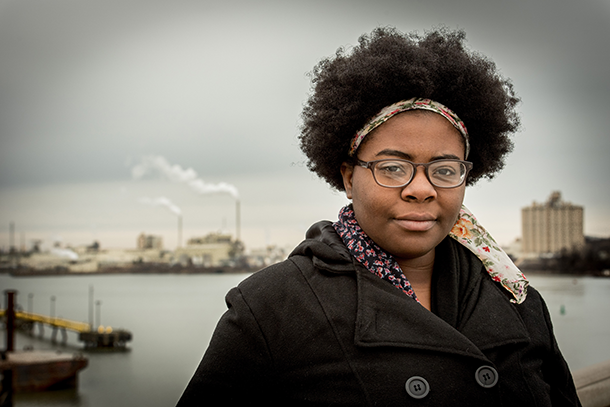
Destiny Watford, the 20-year-old Goldman Prize-winner from Baltimore (Photo: Goldman Environmental Prize)
CURWOOD: North America's winner of the Goldman Environmental Prize is quite a bit younger than Maxima, but she too earned her prize for fighting against a polluting industry in her neighborhood, in this case what would have been the nation's largest trash incinerator. Destiny Watford is now 20 years old, and studying at Towson College. Her environmental activism began as a high school student in South Baltimore, when she found out what the incinerator touted as a source of clean energy meant for her hometown.
WATFORD: Hi, my name is Destiny Watford, I’m from Curtis Bay, which is a small community in Baltimore.
CURWOOD: So, tell us a little bit about Curtis Bay. What's your community like?
WATFORD: Yeah, so Curtis Bay has...it's a small community, but it has a really long history with air pollution. So when you live in Curtis Bay, you're likely to die from lung cancer, respiratory disease and to suffer asthma. We have a lot of things that we are really proud of in our committee like parks and rec centers and community gardens. But it's divided by what seems to be an endless sea of polluting industries. We have the largest medical waste incinerator, coal terminal, the city's landfill. My mom has asthma. My neighbor died of lung cancer. I mean, in Baltimore, the deaths related to air pollution is higher than the homicide rate.
CURWOOD: Really.
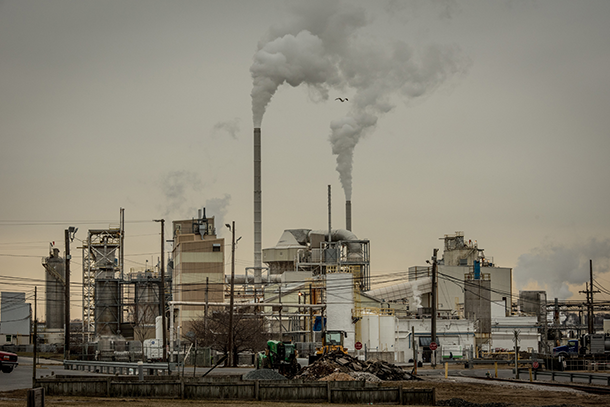
Destiny’s neighborhood Curtis Bay has long had some of the worst air pollution in the country (Photo: Goldman Environmental Prize)
WATFORD: Yeah, just to give you like an idea of how bad it is. I mean, Curtis Bay has some of the worst air pollution in the nation and has the worst air pollution in Maryland.
CURWOOD: Talk to me more about this latest threat to public health in your community. I believe it's the trash incinerator. What exactly is it and what impact do you think that this incinerator would have on public health.
WATFORD: Yeah, so there is a plan to build the nation's largest trash burning incinerator less than a mile away from my high school, Benjamin Franklin, and a group of friends and I joined together to stop it. We learned about the incinerator and we learned that it would have been burning 4,000 tons of trash every day, that is permitted to release 240 pounds of mercury every year and 1,000 pounds of lead. And from the crisis in Flint, we know about how detrimental lead can be even at tiny amounts and the damage that can cause to our health.
CURWOOD: So how did you find out about this project when you were a high school student and how did you get your friends and classmates other young folks involved in the effort to stop it?
WATFORD: So we learned about it through a local newspaper called the Baltimore Brew, and we learned that the project had been going on since 2009 when I was in middle school playing with Barbies and stuff. I didn't even know what incinerator was when I first learned about it and that was the case for a lot of people throughout Curtis Bay including our fellow students. But once we told them the facts of the incinerator and the damage that it could cause to our community, they were immediately against it. So it was really easy to get people to care about the issue because it was an act of survival and their health would be put on the line if it was built.
CURWOOD: So you put together a campaign. What role did things like art play in your campaign?
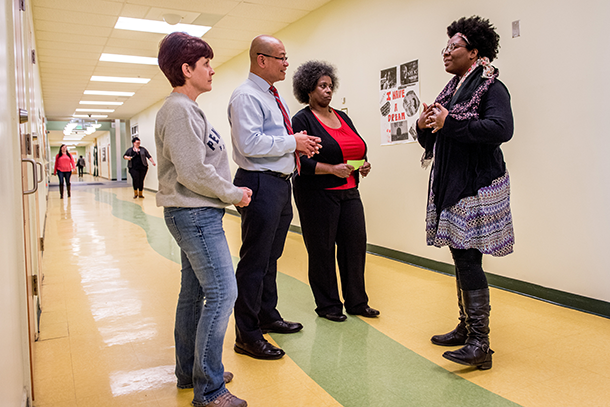
When plans were announced for a new incinerator project in Curtis Bay, Destiny organized her fellow students to help stop the project (Photo: Goldman Environmental Prize)
WATFORD: That's a good question. I actually want to answer with a story. So while we were canvassing one day I knocked on a man's store and he answered and I told him about the incinerator and about the damage it could cause. I asked him how he felt about what he had just learned and if he was interested in learning more. And essentially what he said to me and the group was that, "You know, the work that you kids are doing is pointless. Curtis Bay is and always will be a dumping ground." And that moment kind of served as a transition for us because we recognized that it wasn't going to be enough to just tell people about the incinerator that it was going to take the shift in mentality from passive acceptance of things like the incinerator just because that's kind of the status quo to persistence which would be like saying that just because that was Curtis Bay's history doesn't mean that's has to be its future. To make that shift we relied on the tools that we had, so we weren't lobbyists pushing any political agenda. We were artists, we were poets, we were musicians, we were writers, and so we wrote poems and made music and wrote speeches and articles about what it means to live in a place like Curtis Bay in a place that's been used as a dumping ground and as a place where people's lives will be sacrificed to support the marketplace and we use those tools to shape our narrative and to tell our story in so many different ways and with so many different people that really resonated and began to make that shift and to change people's hearts and minds into thinking that there can be change and there is something that we can do. This isn't the end.
CURWOOD: I understand that you centered your campaign around getting local organizations like public schools to cut their contracts with this incinerator company. How successful has that strategy been?
WATFORD: That was huge. I mean, when we learned that public institutions like the one we knew and love like that Baltimore city public school system or like local museums like the BMA and the Walters Art Museum. We were outraged, but we also recognized that these institutions have the opportunity to make the right choice - we should be investing in not only our future as young people but also the future of our city and of our nation and investing a positive future that doesn't push our lives as risk. So, to answer your question more directly, we used arts to effectively change the hearts and minds of people on the Baltimore city school board by going to a presentation, demonstrating the art that we had created together. I recited a speech about incineration, another member of the group recited a poem that he written, a soliloquy about inspiration in Baltimore and what that means for health. And two members of the group, amazing members who are musicians and rappers, they created what we now call the "Free Your Voice Anthem”that highlighted this tradition between passive acceptance and active resistance in taking a stand.
CURWOOD: So what's the status of this incinerator now?
WATFORD: So, the MDE, which is the Maryland Department of the Environment determined that the incinerator's permits were expired and that came through a long process like months of reaching out to MDE with testimonies and petitions and letters from doctors and environmentalists stating that issues with lead and mercury. We had been sending that stuff to them for months and eventually through a lot of public pressure which included people getting arrested by doing a sit-in at MDE sacrificing their freedom to show that this is a serious issue and a matter of survival. All of that pressure led to MDE determining that Energy Answers’permits were expired which they were. So as of right now the permits that Energy Answers would need to construct, they don't have them. So, the incinerator was stopped.
CURWOOD: Destiny, what does race have to do with this?
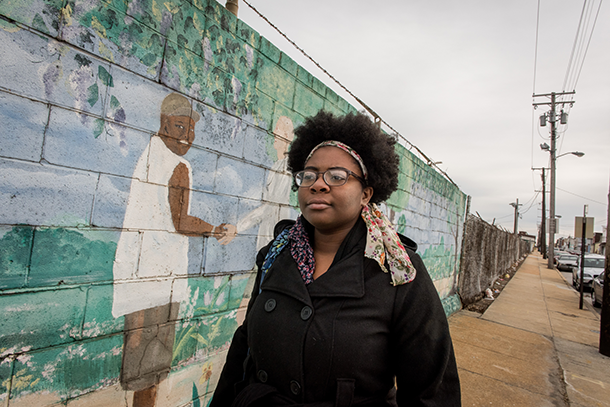
Destiny and her fellow students convinced the school board to cut its contract with the incinerator company. 22 other organizations followed suit. (Photo: Goldman Environmental Prize)
WATFORD: That's a really good question. So, Curtis Bay is a poor neighborhood. It's a food desert and a question that we asked a lot in the group was, why here, why in Curtis Bay? Usually polluting developments like the incinerator project are concentrated in minority and low income areas in places where people have been oppressed, have been taken advantage of for generations for so long, and that there is believed to be this lack of a voice or that people will not resist if this is going to be coming to their community. It is something that we emphasize and a really important piece to mention is that originally back in 2009 when the incinerator was proposed, a community association, a small group of community members, supported the project not because it was this amazing project but because there is so little development that comes to Curtis Bay that the first thing that's offered people take up. And what we've been pushing for more recently is that we can't just accept any developments that come in. Developments that do happen in the community have to be community controlled and don't put our lives at risk.
CURWOOD: Destiny Watford is the one of the winners of this year's Goldman Environmental Prize. Thanks so much for taking the time with us today.
WATFORD: No, thank you!
[RAP, Free Your Voice Anthem, Written and performed by Double Impact; Audrey and Leah Rozier]
[https://vimeo.com/96915571]
If the incinerator takes away a breath
How many do we need
Until there is nothing that’s left?
Until the smoke clogs up
And we can’t feel our chest
And the ones who don't catch the symptoms
Are considered blessed.
The time is now
Before our planet gets destroyed
Before death, is something we cannot avoid
It’s time for change before we don't have a choice
So let's stand tall together, and free our voice.
Chorus:
It'll all get better, we can save the world
And it starts with music, get your message heard
It'll all get better, we can save the world
You gotta free your voice, from all the boys to the girls
Related links:
- Read more about the Goldman Prize
- More about Destiny Watford on the Goldman Environmental Prize website
- Listen to our interview with Jacqui Patterson of the NAACP about environmental justice and air pollution
- Read more about Destiny’s student campaign called “Free Your Voice”
CURWOOD: We leave you this week at the bottom of the world. Listen to the Canada Glacier in the McMurdo dry valley area of Antarctica. It’s a small polar glacier that towers over a lake, and as it melts the water trickles down and the ice creaks. Wind blows much of the time over this bleak but beautiful place, making unearthly noises.
Douglass Quinn recorded this sound portrait for the Wild Sanctuary CD called Antarctica.
[MUSIC: Andanzas, “Amores,” Songs Of South America, Violeta Parra, Northeastern Records]
CURWOOD: Living on Earth is produced by the World Media Foundation. Our crew includes Naomi Arenberg, Bobby Bascomb, Jenni Doering, Emmett Fitzgerald, Helen Palmer, Peter Boucher, Adelaide Chen, Jaime Kaiser, Jennifer Marquis and Jolanda Omari. Tom Tiger engineered our show, with help from Jeff Wade, Jake Rego and Noel Flatt. Alison Lirish Dean composed our themes.You can find us anytime at LOE.org - and like us, please, on our Facebook page - it’s PRI’s Living on Earth. And we tweet from @LivingOnEarth. I'm Steve Curwood. Thanks for listening.
ANNOUNCER1: Funding for Living on Earth comes you, our listeners, and from the University of Massachusetts Boston, in association with its School for the Environment, developing the next generation of environmental leaders. And from the Grantham Foundation for the protection of the environment, supporting strategic communications and collaboration in solving the world’s most pressing environmental problems. And Gilman Ordway for coverage of conservation and environmental change. And from SolarCity, America’s solar power provider. SolarCity is dedicated to revolutionizing the way energy is delivered by giving customers a renewable alternative to fossil fuels. Information at 888-997-1703. That’s 888-997-1703.
ANNOUNCER2: PRI. Public Radio International.
Living on Earth wants to hear from you!
Living on Earth
62 Calef Highway, Suite 212
Lee, NH 03861
Telephone: 617-287-4121
E-mail: comments@loe.org
Newsletter [Click here]
Donate to Living on Earth!
Living on Earth is an independent media program and relies entirely on contributions from listeners and institutions supporting public service. Please donate now to preserve an independent environmental voice.
NewsletterLiving on Earth offers a weekly delivery of the show's rundown to your mailbox. Sign up for our newsletter today!
 Sailors For The Sea: Be the change you want to sea.
Sailors For The Sea: Be the change you want to sea.
 The Grantham Foundation for the Protection of the Environment: Committed to protecting and improving the health of the global environment.
The Grantham Foundation for the Protection of the Environment: Committed to protecting and improving the health of the global environment.
 Contribute to Living on Earth and receive, as our gift to you, an archival print of one of Mark Seth Lender's extraordinary wildlife photographs. Follow the link to see Mark's current collection of photographs.
Contribute to Living on Earth and receive, as our gift to you, an archival print of one of Mark Seth Lender's extraordinary wildlife photographs. Follow the link to see Mark's current collection of photographs.
 Buy a signed copy of Mark Seth Lender's book Smeagull the Seagull & support Living on Earth
Buy a signed copy of Mark Seth Lender's book Smeagull the Seagull & support Living on Earth

